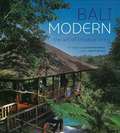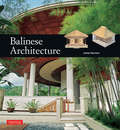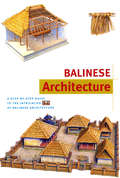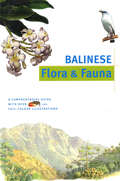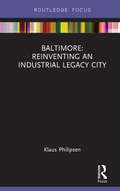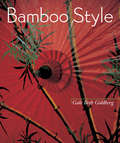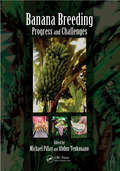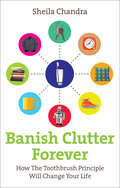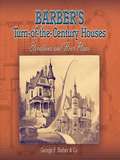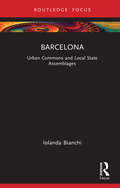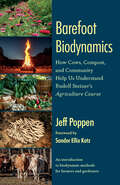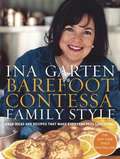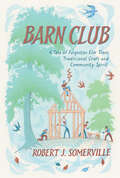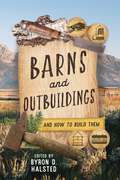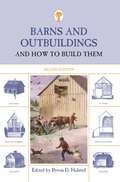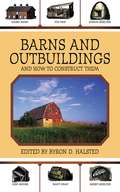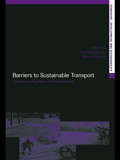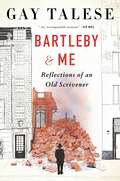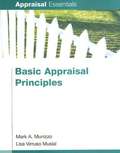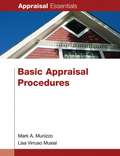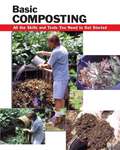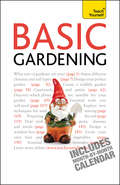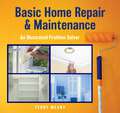- Table View
- List View
Bali Modern
by Luca Invernizzi Tettoni Gianni FrancioneThe Balinese Style of architecture and interior design is renowned and increasingly popular the world over. A thatched Balinese Bale, overlooking a panorama of rice fields and open to the evening breeze, or a courtyard that combines temple carving with relaxing, recreational lounging space are enduring features of a distinctive "Bali-style". Shimmering pavilions, open verandahs, living rooms that invite the outside landscaping in - all are part of the Balinese tropical living experience This book focuses on these timeless features and shows the new and exciting ways in which they are interpreted. All the contemporary villas, resort bungalows, shops, restaurants and other buildings in the book, most never photographed before, are new additions to the Bali scene. Each is unique, and, most importantly characterized by a distinctly modern feel. Cleaner lines, more imaginative use of space, sharp angles, and the use of stone, concrete and ceramic roof tiles, are increasingly visible along with the coconut wood, teak and thatching.Shot entirely on location, superb color photographs depict the residences set within their natural landscapes; architectural details; and a stunning array of individual interiors. Meticulous text compiled by an expert in tropical design, relates the various stages of the development of this new, international style, and complements the fascinating array of interiors featured
Balinese Architecture
by Luca Invernizzi Tettoni Bruce Granquist Davison Julian Nengah Enu Mubinas HanafiBalinese style villas and resorts are popping up everywhere-from Ibiza to St Barts to Singapore. But what is Balinese architecture? And why is it so popular today?Traditional Balinese houses, temples and pavilions are designed to allow man to exist in harmony with the natural forces of the universe-reflecting core Balinese beliefs about man's place in relation to the cosmos, the gods, the ancestors, and the world around him. Innovative local and Western architects have been designing resorts and villas on Bali for decades, drawing their inspiration from these local traditions.In this one-of-a-kind book, author Julian Davison provides a comprehensive guide to Balinese architectural forms, the Balinese belief system, the rituals associated with building, the materials and construction techniques, and the intricate ornamentation used. Over 100 watercolor illustrations and photographs provide a clear picture of the island's architecture as well as an eye-opening look at a culture and a people that have captivated the world's imagination.
Balinese Architecture Discover Indonesia
by Julian Davison Bruce GranquistBalinese Architecture is a step-by-step guide to the intricacies of Balinese vernacular architecture, the written word being complemented throughout by watercolor illustrations of different building types, design concepts and construction techniques.
Balinese Flora & Fauna Discover Indonesia
by Julian Davison Bruce GranquistThis book provides a general introduction to the natural history of Bali, looking at each of the major ecosystems in turn and highlighting their most salient and interesting features. Watercolor panoramas and illustrations of typical or otherwise significant plants and animals from each type of habitat complement the text and provide the reader with a visual reference for some of the sights he or she is most likely to see during a visit to the island.
Balinese Gardens
by Luca Invernizzi Tettoni William WarrenThis guided tour of Bali's finest traditional and contemporary gardens is perfect for gardening enthusiasts and professional landscape architects alike, and will especially appeal to visitors who have experienced the charms of one of the world's most beautiful islands.
Baltimore: Reinventing an Industrial Legacy City (Built Environment City Studies)
by Klaus PhilipsenBaltimore: Reinventing an Industrial Legacy City is an exploration into the reinvention, self-reflection and boosterism of US legacy cities, taking Baltimore as the case study model to reveal the larger narrative. Author Klaus Philipsen investigates the modern urban condition and the systemic problems involved with adapting metropolitan regions into equitable and sustainable communities, covering topics such as growth, urban sprawl, the depletion of cities, social justice, smart city and open data, transportation, community development, sustainability and diversity. Baltimore’s proximity to the US capital, combined with its industrial past, presents the optimum viewpoint to investigate these challenges and draw parallels with cities across the world.
Bamboo Style
by Gale Beth GoldbergAn architect and bamboo expert shares a wealth of home design inspirations that demonstrate the beauty, utility, and endless versatility of bamboo. In Bamboo Style, architect and author Gale Goldberg shows you how to incorporate bamboo throughout your home, from interior decorations to outdoor structures and even growing your own bamboo plants. Bamboo is highly versatile and requires little care, yet its visual appeal can change a mundane setting into an exotic oasis. Every room in your home can benefit from beautiful, sensual bamboo furniture, flooring, wall covering, ceiling material and accessories. Bamboo Style includes a resource directory of designers, manufacturers, artists, suppliers and bamboo organizations. For do-it-yourselfers, the bamboo projects in this book—from a simple ladle to an impressive garden pergola—will inspire you with the endless creative possibilities of bamboo.
Banana Breeding: Progress and Challenges
by Michael Pillay Abdou TenkouanoWith the current world population growth of 1.2%, the earth can expect to house 9-10 billion people by 2050. Food production, too, must increase to accommodate these numbers. Easy growing, high calorie, nutritious foods, such as bananas are the top priority as a solution to this imminent problem. The first comprehensive compendium on bananas in rec
Banish Clutter Forever: How the Toothbrush Principle Will Change Your Life
by Sheila ChandraWhy is it that even the most disorganised person never seems to lose their toothbrush? How can this simple fact solve all our clutter problems?The Toothbrush Principle is a simple yet inspired approach to de-cluttering your home. Whether you live in a mansion or a bedsit, this book will show you how to: organise according to the unconscious blueprint that naturally tidy people have, so that getting and staying organised is easy; know what to throw away with confidence; set up your wardrobe so you get much more use out of the clothes you have; work from home productively in a clear, designated space; tame your inbox!Step-by-step, room-by-room, you'll soon find that you hardly ever lose things, massive clear outs become a thing of the past and you never spend more than 10 minutes a day tidying up.So stop drowning in piles of clutter, learn how to be organised and start creating space to live out the life of your dreams!
Barber's Turn-of-the-Century Houses: Elevations and Floor Plans (Dover Architecture)
by George F. BarberAt the turn of the twentieth century, George F. Barber ran a successful architectural firm. Today, surviving examples of Barber's signature designs are the pride of their communities. This architectural snapshot from 1901 features working floor plans and fine drawings of more than eighty of Barber's distinctive dwellings.Specializing in serving a mail-order clientele, Barber's company produced catalogs "giving floor plans of a convenient and practical character, and exterior designs of artistic merit in the various prevailing styles." Prepared from long, practical experience, the handsome designs and plans range from the modest to the magnificent, including stately Georgians and colonials as well as snug country homes and seaside cottages. Loaded with spacious kitchens and double parlors as well as porches and balconies of beautiful classic design, this authentic guide will fascinate architectural historians, preservationists, and home restorers, along with anyone interested in Victorian-era architecture.
Barcelona: Urban Commons and Local State Assemblages (Built Environment City Studies)
by Iolanda BianchiThis book explores the complex relationship between urban commons – understood as a repertoire of collective action that fosters a politics of antagonism – and the local state. It critiques the dominant neo-institutionalist and neo-Marxist perspectives for their deterministic and siloed views, as well as the insufficient attention they pay to the municipal scale. The book proposes a more nuanced, urban-based, outcome-oriented approach rooted in assemblage theory.The analysis addresses a central question: can urban commons-local state assemblages benefit the politics of urban commons? The book argues that they can, provided they form rhizomatic assemblages. These allow urban commons to retain their self-governing autonomy, even as they lose some of their material autonomy. Conversely, it shows that assemblages can also take arborescent forms, allowing the local state to undermine the self-governing autonomy of the urban commons.Focusing on Barcelona, the book examines how rhizomatic and arborescent assemblages are constructed, as well as the strategies that urban commons can undertake to build rhizomatic assemblages. This book is essential for scholars, policymakers, and activists interested in urban governance, commons theory and transformative politics. It provides both theoretical insights and practical tools for harnessing the dynamics of the urban commons and the local state to drive meaningful socio-political change.
Barefoot Biodynamics: How Cows, Compost, and Community Help Us Understand Rudolf Steiners Agriculture Course
by Jeff PoppenWith decades of knowledge and proven, common-sense methods from &“The Barefoot Farmer,&” this practical guide to biodynamic principles and practices will appeal to growers of every scale and experience level."An excellent read for all who want to understand the keys to growing nutrient-dense food."—Gabe Brown, author of Dirt to Soil; co-founder, Understanding AgIn Barefoot Biodynamics, organic grower Jeff Poppen—&“The Barefoot Farmer&”—combines tales from his personal history in rural Tennessee with the practical applications of biodynamic principles and the deep aspects of the biodynamic methods that continue to make his farm a success today.Jeff&’s friendly, direct, and humorous writing will appeal not only to the biodynamic-curious, but also to farmers and gardeners who have experimented with the biodynamic approach and are looking for a deeper understanding of the practice.Rooted in the teachings of biodynamic pioneer Rudolf Steiner, Jeff&’s unique insights and deep reflections on &“guiding lines&” of biodynamic growing are an invaluable resource. Those &“guiding lines&” include:producing a farm&’s fertility using cover crops, compost, and other on-farm inputsenjoying the renewing power of farm festivalsaugmenting scientific knowledge with the power of observation and intuitionavoiding chemical fertilizersunderstanding that carbon, oxygen, nitrogen, and hydrogen make up 95 percent of the physical structure of plants and are freely available in the air around usenhancing the availability of critical minerals such as silica and lime through good farming practicesbuilding humus-rich soil teeming with microbial lifeusing homeopathic preparations to heal and enrich the soilIn addition, Jeff walks the reader through the eight lectures on farming given by Steiner in 1924, summarizing important points from each lecture and &“translating&” them from Steiner&’s profound yet sometimes impenetrable vocabulary into plain language. In Barefoot Biodynamics, Jeff provides new insight into these enigmatic lectures, revealing an often overlooked yet cost-effective farming method rooted in common sense.
Barefoot Contessa Family Style: Easy Ideas and Recipes That Make Everyone Feel Like Family
by Ina GartenIna Garten, who shared her gift for casual entertaining in the bestselling Barefoot Contessa Cookbook and Barefoot Contessa Parties, is back with her most enticing recipes yet-- a collection of her favorite dishes for everyday cooking. In Barefoot Contessa Family Style, Ina explains that sharing our lives and tables with those we love is too essential to be saved just for special occasions-- and it's easy to do if you know how to cook irresistible meals with a minimum of fuss. For Ina, the best way to make guests feel at home is to serve them food that's as unpretentious as it is delicious. So in her new book, she's collected the recipes that please her friends and family most-- dishes like East Hampton Clam Chowder, Parmesan Roasted Asparagus, and Linguine with Shrimp Scampi. It's the kind of fresh, accessible food that's meant to be passed around the table in big bowls or platters and enjoyed with warm conversation and laughter. In Ina's hands tried-and-true dishes are even more delicious than you remember them: Her arugula salad is bright with the flavors of lemon and Parmesan, the Oven-Fried Chicken is crispy without excess fat, and her Deep-Dish Apple Pie has the perfect balance of fruit and spice. Barefoot Contessa Family Style also includes enticing recipes that are memorable and distinctive, like Lobster Cobb Salad, Tequila Lime Chicken, and Saffron Risotto with Butternut Squash. With vivid photographs of Ina cooking and serving food in her beautiful Hamptons home, as well as menu suggestions, practical wisdom on what to do when disaster strikes in the kitchen, and tips on creating an inviting ambiance with music, Barefoot Contessa Family Style is the must-have guide to the joy of everyday entertaining.
Barn Club: A Tale of Forgotten Elm Trees, Traditional Craft and Community Spirit
by Robert Somerville"In today’s ego-techno-centred world, Robert Somerville’s… ‘Barn Club’ approach is a way forward that utilizes local traditions, local materials and local hands to create a built environment that is more harmonious with the natural world and of course more beautiful."—Jack A. Sobon, architect, timber framer, and author of Hand Hewn Natural history meets traditional hand craft in this celebration of the elm tree and community spirit. Perfect for fans of Norwegian Wood and The Hidden Life of Trees Barn Club calls on us to discover our landscapes more intimately and to explore the joys of making beautiful things by hand, together. When renowned craftsman Robert Somerville moved to Hertfordshire, in southern England, he discovered an unexpected landscape rich with wildlife and elm trees. Nestled within London’s commuter belt, this wooded farmland inspired Somerville, a lifelong woodworker, to revive the ancient tradition of hand-raising barns. Barn Club follows the building of Carley Barn, over the course of one year. Volunteers from all walks of life joined Barn Club, inspired to learn this ancient skill of building elm barns by hand, at its own quiet pace and in the company of others, while using timber from the local woods. The tale of the elm tree in its landscape is central to Barn Club. Its natural history, historic importance, and remarkable survival make for a fascinating story. This is a tale of forgotten trees, a local landscape, and an ancient craft. This book features 16 pages of color photographs, and black and white line drawings of techniques and traditional timber frame barns feature throughout.
Barns and Outbuildings: And How to Build Them
by Byron D. HalstedA fascinating tribute to the beauty of the farm and the ingenuity of the American farmerFirst published in 1881, Barns and Outbuildings presents dozens of practical examples of barns and outbuildings, both large and small, complete with 250 illustrations, floor plans, and building instructions for easy use.Inside you will find a wealth of design ideas for: Chicken coopsWestern cattle barns with covered stallsPortable pigpens with self-closing doorsDairy, sheep, and horse barnsIce houses and spring housesSmoke housesGranariesDog, bird, and pigeon housesAnd much more!Also included are tips on how to choose the correct foundation and materials for your structure and how to consider the overall aesthetics of your farm when planning your new building. Combining sturdy practicality with fine craftsmanship, Barns and Outbuildings is an excellent homesteading helper that will engage new audiences, from builders to history buffs to craft lovers.
Barns and Outbuildings: And How to Build Them
Time-honored designs for erecting any farm structure from dairy barn to smokehouse. Includes 250 historical and practical illustrations.
Barns and Outbuildings: And How to Construct Them (Lyons Press Ser.)
by Byron D. HalstedFirst published in 1881, this classic volume presents dozens of practical examples of barns and outbuildings-including floor plans and building instructions-and contains two hundred and fifty-seven engravings, woodcuts, and line drawings illustrating historical and practical designs. Featured designs include cattle barns, pigpens, pigeon houses, self-feeding corncribs, self-closing doors, icehouses, springhouses, granaries, horse barns, dog houses, and much more. Halsted also provides suggestions on the placement of outbuildings and on choosing the cor-rect materials for foundations, walls, and roofs. This new release of Barns and Outbuildings-a tribute to the beauty of the farm and the ingenuity of the farmer-will engage new audiences, from builders and organic gardeners to history buffs and craft lovers.
Barriers to Sustainable Transport: Institutions, Regulation and Sustainability (Transport, Development and Sustainability Series)
by Roger R. Stough Piet RietveldThe complexity of transportation systems and their negative social and environmental effects are today at the centre of attention. This book focuses on the impact of institutions and regulatory systems on transport systems and travel behaviour. While institutions appear to play an important role in the economic success of many countries, this book considers the extent to which they also support sustainable development.
Bartleby and Me: Reflections of an Old Scrivener
by Gay Talese“Literary Legend” (New York) Gay Talese retraces his pioneering career, marked by his fascination with the world's hidden characters.In the concluding act of this "incomparable" (Air Mail) capstone book, Talese introduces readers to one final unforgettable story: the strange and riveting all new tale of Dr. Nicholas Bartha, who blew up his Manhattan brownstone—and himself—rather than relinquish his claim to the American dream.“New York is a city of things unnoticed,” a young reporter named Gay Talese wrote sixty years ago. He would spend the rest of his legendary career defying that statement by celebrating the people most reporters overlooked, understanding that it was through these minor characters that the epic story of New York and America unfolded. Inspired by Herman Melville’s great short story “Bartleby, the Scrivener,” Talese now revisits the unforgettable “nobodies” he has profiled in his celebrated career—from the New York Times’s anonymous obituary writer to Frank Sinatra’s entourage. In the book’s final act, a remarkable piece of original reporting titled “Dr. Bartha’s Brownstone,” Talese presents a new “Bartleby,” an unknown doctor who made his mark on the city one summer day in 2006. Rising within the city of New York are about one million buildings. These include skyscrapers, apartment buildings, bodegas, schools, churches, and homeless shelters. Also spread through the city are more than 19,000 vacant lots, one of which suddenly appeared some years ago—at 34 East 62nd Street, between Madison and Park Avenues—when the unhappy owner of a brownstone at that address blew it up (with himself in it) rather than sell his cherished nineteenth-century high-stoop Neo-Grecian residence in order to pay the court-ordered sum of $4 million to the woman who had divorced him three years earlier. This man was a physician of sixty-six named Nicholas Bartha. On the morning of July 10, 2006, Dr. Bartha filled his building with gas that he had diverted from a pipe in the basement, and then he set off an explosion that reduced the fivestory premises into a fiery heap that would injure ten firefighters and five passersby and damage the interiors of thirteen apartments that stood to the west of the crumbled brownstone.Talese has been obsessed with Dr. Bartha’s story and spent the last seventeen years examining this single 20 x 100 foot New York City building lot, its serpentine past, and the unexpected triumphs and disasters encountered by its residents and owners—an unlikely cast featuring society wannabes, striving immigrants, Gilded Age powerbrokers, Russian financiers, and even a turncoat during the War of Independence—just as he has been obsessed with similar “nobodies” throughout his career. Concise, elegant, tragic, and whimsical, Bartleby and Me is the valedictory work of a master journalist.
Basic Appraisal Principles
by Mark A. Munizzo Lisa Virruso MusialThis 30-hour text is designed to be used with Basic Appraisal Procedures to meet the suggested first 60 hours of core content for appraisal trainees under the 2008 AQB Criteria.
Basic Appraisal Procedures
by Mark A. Munizzo Lisa Virruso MusialProcedures used in appraising residential and commercial real estate.
Basic Composting (How To Basics)
by Carl HurshEach technique illustrated with color photos. Details on what and what not to compost. Suggested uses for finished compost.
Basic Gardening: A step by step guide to garden care and growing fruit, flowers and vegetables
by Jane McMorland HunterTeach Yourself - the world's leading learning brand - is relaunched in 2010 as a multi-platform experience that will keep you motivated to achieve your goals. Let our expert author guide you through this brand new edition, with personal insights, tips, energising self-tests and summaries throughout the book. Go online at www.teachyourself.com for tests, extension articles and a vibrant community of like-minded learners. And if you don't have much time, don't worry - every book gives you 1, 5 and 10-minute bites of learning to get you started.""Basic Gardening"" features step-by-step guidelines to every aspect of garden care.It covers all the basics, taking nothing for granted, in addition to lots of information on areas of topical interest, such as how to save water during a drought period and how to compost. With straightforward guidelines for growing your own fruit and vegetables, ""Basic Gardening"" shows you how to turn a patch of muddy ground into an easily maintainable garden, whatever the size of your plot and however busy you are. From lawn care and watering to creating patios and growing vegetables, it is packed with easy-to-follow, practical advice.
Basic Gardening: A step by step guide to garden care and growing fruit, flowers and vegetables (Teach Yourself General)
by Jane McMorland HunterTeach Yourself - the world's leading learning brand - is relaunched in 2010 as a multi-platform experience that will keep you motivated to achieve your goals. Let our expert author guide you through this brand new edition, with personal insights, tips, energising self-tests and summaries throughout the book. Go online at www.teachyourself.com for tests, extension articles and a vibrant community of like-minded learners. And if you don't have much time, don't worry - every book gives you 1, 5 and 10-minute bites of learning to get you started.""Basic Gardening"" features step-by-step guidelines to every aspect of garden care.It covers all the basics, taking nothing for granted, in addition to lots of information on areas of topical interest, such as how to save water during a drought period and how to compost. With straightforward guidelines for growing your own fruit and vegetables, ""Basic Gardening"" shows you how to turn a patch of muddy ground into an easily maintainable garden, whatever the size of your plot and however busy you are. From lawn care and watering to creating patios and growing vegetables, it is packed with easy-to-follow, practical advice.
Basic Home Repair & Maintenance: An Illustrated Problem Solver (Knack: Make It Easy)
by Terry MeanyDon't panic at the prospect of home repair and maintenance! With this informative and well-organized guide you'll have the knowledge and instruction you need to deal with or prevent scores of the most common problems in your home. Its 460 full-color photographs and step-by-step instructions show you how things work, what can go wrong, and whether there is a quick fix. You'll know when to call repair service and when you can do the work yourself. From painting to electrical work, plumbing, and maintenance, this book makes home repair and maintenance projects easy, providing clear, commonsense ways to save time and money. Topics covered include:Guidance on assessing the problem Essential information on tools, supplies and techniques every homeowner should have How to Paint Fixing scratches, squeaks, scrapes and chips Repairing leaks and clogs Electrical repairs you can do Dealing with mold, mildew, moss and dry rot Yard work Running an energy efficient homeAn extensive resource guide to products and Web sources is provided as well.
